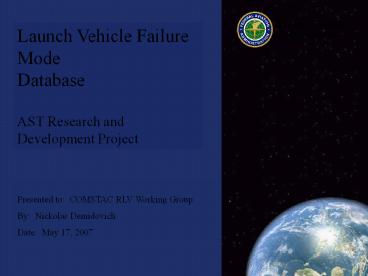Launch Vehicle Failure Mode PowerPoint PPT Presentation
Title: Launch Vehicle Failure Mode
1
Launch Vehicle Failure Mode Database AST
Research and Development Project
Presented to COMSTAC RLV Working Group By
Nickolas Demidovich Date May 17, 2007
2
Overview
- Historical Database Tasking
- Phase 1
- Phase 2
- Status
- Findings to date
- Overall
- Trends
- Scope of Phase 2
- Path Forward
- Questions/Discussion
3
Historical Database
- Description of Project
- AST should compile and maintain a database of
historical data on failures and reliability of
rocket-powered vehicles. An exhaustive database
would include not only percentage reliability and
number of vehicles, but type and class of vehicle
and, to the extent possible, the results of the
failure analysis. The ultimate goal is to provide
the industry with insight into what fails and
why. - Phase 1 orbital space launch vehicles
- Phase 2 available data on suborbital rocket
powered (non-missile) vehicles (X-15 and others) - Schedule
- Study Period November 2006 June 2007
- Draft Report Aug 2007
- Briefing Next COMSTAC
- Goal
- Enhance Safety
4
Status of Phase 1
- Historical Database on ELVs was created using
open-source documentation on known failures - Database is Not proprietary
- Database is Not ITAR controlled
- Database is Preliminary
- Timeframe 1957-2007
- 28 percent of all launch failures over entire
period had unknown failures - Early Soviet (late 50s and 60s) data not
publicly available - Failure is as defined in FAA/AST report Guide
to Probability of Failure Analysis for New
Expendable Launch Vehicles - An in-flight failure occurs when a launch
vehicle does not complete any phase of normal
flight.
5
Status of Phase 1
- Launch vehicle Database Sources
- Periodicals (i.e. Satellite News Digest, Janes
Space Directory etc) - Books (i.e. Encyclopedia Astronautica,
Spaceflight and Rocketry, International Reference
Guide to Space Launch Systems, etc) - Futron Corporation database from 1957
- Electronic Library of Space Activity (ELSA)
- Press releases
- Cross checked data base with internet sites
- USAF, NASA , etc
6
Known Cause of ELV Launch Failures Worldwide by
Vehicle Subsystem 1957- May 2007
- Propulsion anomalies
- are salient failure
- mode historically
7
Known Cause of Launch Failures Worldwide by
Vehicle Subsystem 1980-May 2007
- Propulsion anomalies
- remain salient
- failure mode to date
8
ELV Launch Failures Relative to Total Launches
US Soviet Early Launches
Initial Launches By New Entrants
9
Percentage of Failed ELV Launches by Country and
Decade
10
Summary of Findings to Date - Trends
- 39 percent occur of failures occur during
operation of the final stage - US vehicles have improved in this regard since
1990s - Nations generally have early surge in failure
- Then decline and level off
- Propulsion anomalies have been and continue to
cause most known failures in ELV launches - All nations
- Liquid, solid and combination
11
Summary of Findings to Date - Trends
- Guidance and navigation have historically been
second leading cause of failure - Have dropped over time
- Software and computing systems are a growing
concern - 8 of failures from 1990-1999
- 21 of failures since 1999
12
Scope of phase 2
- Historical database on failures of rocket-powered
aircraft currently being scoped - Database to focus on
- Post-World War II U.S. government and commercial
rocket-powered aircraft (such as X-planes, etc.) - Other Western post-World War II rocket-powered
aircraft (such as French and British jets with
auxiliary rocket engines) - Post-World War II Soviet rocket-powered aircraft
- World War II and earlier projects (German ME 163,
etc.) - Research to include NASA logs and other primary
sources
13
Path Forward
- Updating ELV Database as launches occur
- Historical Database of rocket powered lifting
bodies in progress - Scoping for Relevance
- Will update summary and database by next COMSTAC
- Provides opportunity for RLV community to learn
from anomalies in ELVs and rocket-powered lifting
bodies

